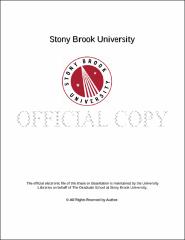| dc.identifier.uri | http://hdl.handle.net/11401/76422 | |
| dc.description.sponsorship | This work is sponsored by the Stony Brook University Graduate School in compliance with the requirements for completion of degree. | en_US |
| dc.format | Monograph | |
| dc.format.medium | Electronic Resource | en_US |
| dc.language.iso | en_US | |
| dc.publisher | The Graduate School, Stony Brook University: Stony Brook, NY. | |
| dc.type | Dissertation | |
| dcterms.abstract | As healthcare grows more advanced, the next step is an individualized approach to patient care. Skeletal tumor resection provides complex challenges for surgeons. The goal of providing an accurate wide resection in sarcomas from preoperative plans while trying to preserve as much functionality remains a difficult task. We propose to leverage new devel- opments in 3-D printing, computer aided design (CAD), and finite element analysis (FEA) to design and manufacture personalized cutting guides in order to increase the accuracy of childhood bone cancer resections, minimize post-resection fracture risk, and maximize al- lograft osteointegration. On the other side, after proper resection, successful reconstruction of the defect left in the bone is the next step to complete the surgical procedure. Recent technological advancements in three-dimensional (3D) printing have opened many possi- bilities for bone engineering. 3D printing is one of the best techniques for custom design of synthetic bone because it is highly specific to the implantable structure. Synthetic bone scaffolds have been used to replace diminished bone stock, aid in fracture repair, and assist in the integration of orthopedic implants with native bone. The best bone scaffolds should be able to withstand heavy loads and allow for osteoconductivity. However, current 3D printing bone technologies can create either hard inert bone structures that are structurally compatible but functionally inert, or fragile soft structures that have osteoconductive prop- erties but are extremely weak in structure. We present a novel technique to create artificial bone that can mimic natural bone. Our work is guided by two main goals: 1) Increase the quality of life for patients by precisely removing the minimum amount of healthy tis- sue without compromising the surgeons ability to remove the entire tumor; 2) Provide a biomimetic and biocompatible implant with an optimal fit. | |
| dcterms.available | 2017-09-20T16:50:14Z | |
| dcterms.contributor | Kao, Imin | en_US |
| dcterms.contributor | Ge, Jeffrey | en_US |
| dcterms.contributor | Chakraborty, Nilanjan | en_US |
| dcterms.contributor | Khan, Fazel | en_US |
| dcterms.contributor | Pentyala, Srinivas N | en_US |
| dcterms.contributor | Komatsu, David E. | en_US |
| dcterms.creator | Helguero Alcivar, Carlos Gabriel | |
| dcterms.dateAccepted | 2017-09-20T16:50:14Z | |
| dcterms.dateSubmitted | 2017-09-20T16:50:14Z | |
| dcterms.description | Department of Mechanical Engineering | en_US |
| dcterms.extent | 140 pg. | en_US |
| dcterms.format | Monograph | |
| dcterms.format | Application/PDF | en_US |
| dcterms.identifier | http://hdl.handle.net/11401/76422 | |
| dcterms.issued | 2016-12-01 | |
| dcterms.language | en_US | |
| dcterms.provenance | Made available in DSpace on 2017-09-20T16:50:14Z (GMT). No. of bitstreams: 1
HelgueroAlcivar_grad.sunysb_0771E_12944.pdf: 201576426 bytes, checksum: 818f88c6bd065ab4d4d0556545446aac (MD5)
Previous issue date: 1 | en |
| dcterms.publisher | The Graduate School, Stony Brook University: Stony Brook, NY. | |
| dcterms.subject | 3D printing, Bio Printing, bone tumor resection, customized cutting guides, Image Processing | |
| dcterms.subject | Mechanical engineering -- Biomedical engineering -- Medicine | |
| dcterms.title | Engineering Interface and Analysis in Orthopedic Surgery: Resection of Bone Tumors and Reconstruction using Biomimetic Implants | |
| dcterms.type | Dissertation | |

